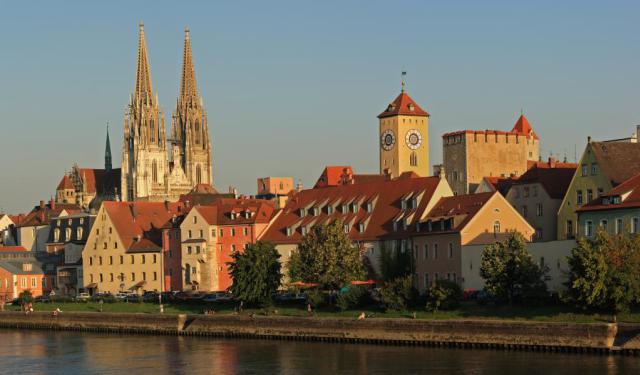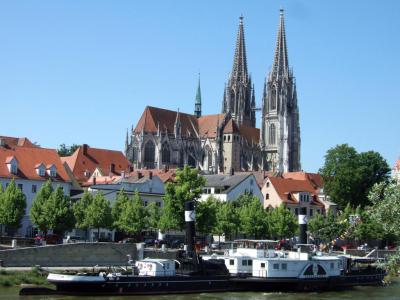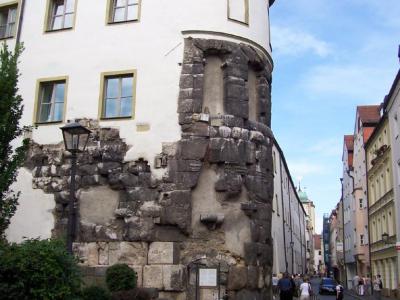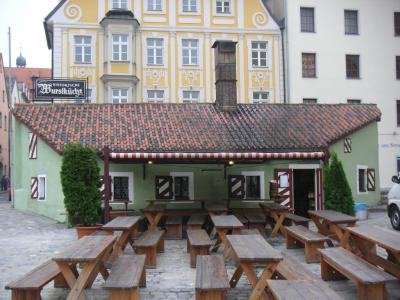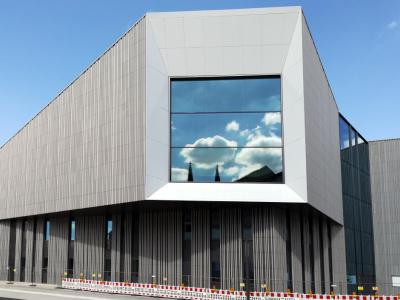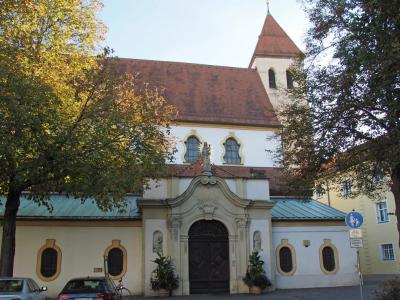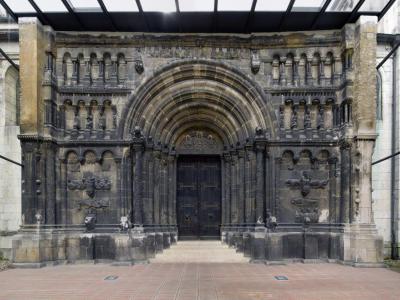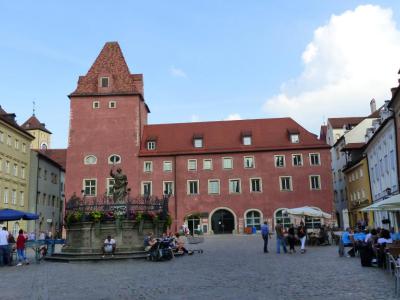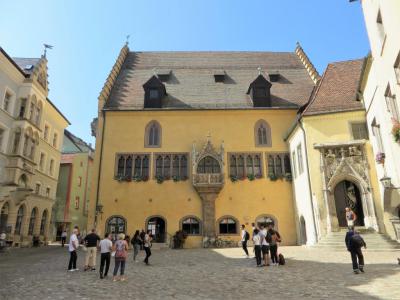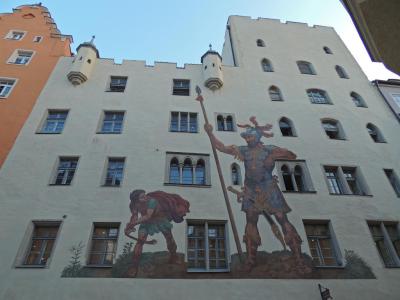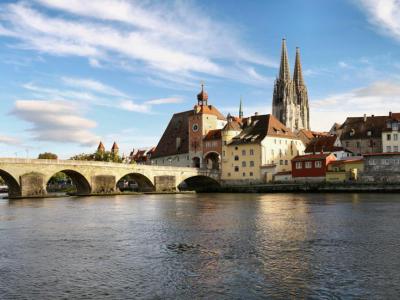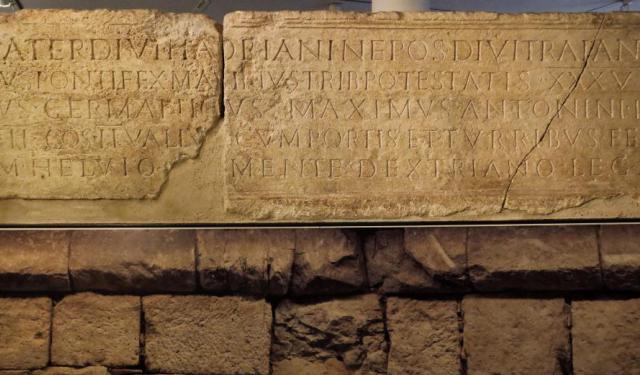Audio Guide: Regensburg Introduction Walking Tour (Self Guided), Regensburg
During a battle in 1809, Napoleon remarked that Regensburg was “worth a crown.”
The name “Regensburg” reflects its roots: it comes from the River Regen, which joins the Danube here, and the Old High German word burg, meaning fortress—so Regensburg means “the fortress by the Regen.”
Long before the Romans, Celtic tribes had already settled on the high ground, taking advantage of the site’s natural defenses and waterways. In 179 AD, under Emperor Marcus Aurelius, the Romans established the fortress Castra Regina as a base for the Third Legion. From its walls, Roman soldiers guarded the frontier and controlled vital trade routes along the Danube. Even after Rome’s collapse in the 5th century, the settlement endured, maintaining its central role in commerce and administration.
By the early Middle Ages, Regensburg had become a major center of power in Bavaria. It was both a ducal and episcopal seat. Under the Carolingians, it became a royal residence and one of the most significant cities in the eastern Frankish kingdom. Between the 9th and 13th centuries, the city experienced a golden age, flourishing as a hub of trade. Its strategic location at the northernmost bend of the Danube made it a gateway to Eastern Europe and the Black Sea, where merchants exchanged salt, furs, and luxury goods.
Regensburg’s importance only grew during the medieval period. As a Free Imperial City of the Holy Roman Empire, it enjoyed a high degree of autonomy, fostering both commerce and culture. The city also played a role in the Protestant Reformation, adding to its legacy of political and spiritual influence. Its political weight was most evident between 1663 and 1806, when Regensburg became the permanent seat of the Imperial Diet—the Holy Roman Empire’s governing assembly. For nearly 150 years, the fate of Central Europe was debated within its walls.
Though its prominence declined after the fall of the Holy Roman Empire and the rise of new trade centers, Regensburg weathered centuries of upheaval with resilience. Remarkably, it emerged from World War II with little damage, preserving its medieval core of Gothic and Renaissance streetscapes.
Walking through downtown Regensburg today, you’ll see a beautifully preserved medieval cityscape with narrow cobblestone streets, colorful facades, and soaring Gothic architecture. Highlights include the majestic Regensburg Cathedral, the 12th-century Stone Bridge over the Danube, and charming town squares like Haidplatz. Roman ruins, historic churches, and cozy cafés line the route. The Old Town, a UNESCO World Heritage Site, offers a blend of ancient history and vibrant modern life in a walkable, atmospheric setting.
As you explore its streets, you’ll begin to understand why Napoleon believed this city—steeped in history and commanding in presence—was worth a crown.
The name “Regensburg” reflects its roots: it comes from the River Regen, which joins the Danube here, and the Old High German word burg, meaning fortress—so Regensburg means “the fortress by the Regen.”
Long before the Romans, Celtic tribes had already settled on the high ground, taking advantage of the site’s natural defenses and waterways. In 179 AD, under Emperor Marcus Aurelius, the Romans established the fortress Castra Regina as a base for the Third Legion. From its walls, Roman soldiers guarded the frontier and controlled vital trade routes along the Danube. Even after Rome’s collapse in the 5th century, the settlement endured, maintaining its central role in commerce and administration.
By the early Middle Ages, Regensburg had become a major center of power in Bavaria. It was both a ducal and episcopal seat. Under the Carolingians, it became a royal residence and one of the most significant cities in the eastern Frankish kingdom. Between the 9th and 13th centuries, the city experienced a golden age, flourishing as a hub of trade. Its strategic location at the northernmost bend of the Danube made it a gateway to Eastern Europe and the Black Sea, where merchants exchanged salt, furs, and luxury goods.
Regensburg’s importance only grew during the medieval period. As a Free Imperial City of the Holy Roman Empire, it enjoyed a high degree of autonomy, fostering both commerce and culture. The city also played a role in the Protestant Reformation, adding to its legacy of political and spiritual influence. Its political weight was most evident between 1663 and 1806, when Regensburg became the permanent seat of the Imperial Diet—the Holy Roman Empire’s governing assembly. For nearly 150 years, the fate of Central Europe was debated within its walls.
Though its prominence declined after the fall of the Holy Roman Empire and the rise of new trade centers, Regensburg weathered centuries of upheaval with resilience. Remarkably, it emerged from World War II with little damage, preserving its medieval core of Gothic and Renaissance streetscapes.
Walking through downtown Regensburg today, you’ll see a beautifully preserved medieval cityscape with narrow cobblestone streets, colorful facades, and soaring Gothic architecture. Highlights include the majestic Regensburg Cathedral, the 12th-century Stone Bridge over the Danube, and charming town squares like Haidplatz. Roman ruins, historic churches, and cozy cafés line the route. The Old Town, a UNESCO World Heritage Site, offers a blend of ancient history and vibrant modern life in a walkable, atmospheric setting.
As you explore its streets, you’ll begin to understand why Napoleon believed this city—steeped in history and commanding in presence—was worth a crown.
How it works: Download the app "GPSmyCity: Walks in 1K+ Cities" from Apple App Store or Google Play Store to your mobile phone or tablet. The app turns your mobile device into a personal tour guide and its built-in GPS navigation functions guide you from one tour stop to next. The app works offline, so no data plan is needed when traveling abroad.
Regensburg Introduction Walking Tour Map
Guide Name: Regensburg Introduction Walking Tour
Guide Location: Germany » Regensburg (See other walking tours in Regensburg)
Guide Type: Self-guided Walking Tour (Sightseeing)
# of Attractions: 11
Tour Duration: 2 Hour(s)
Travel Distance: 4.1 Km or 2.5 Miles
Author: DanaOffice
Sight(s) Featured in This Guide:
Guide Location: Germany » Regensburg (See other walking tours in Regensburg)
Guide Type: Self-guided Walking Tour (Sightseeing)
# of Attractions: 11
Tour Duration: 2 Hour(s)
Travel Distance: 4.1 Km or 2.5 Miles
Author: DanaOffice
Sight(s) Featured in This Guide:
- Regensburg Cathedral
- Porta Praetoria (Praetorian Gate)
- Historische Wurstküche (Regensburg Sausage Kitchen)
- Museum of Bavarian History
- Basilica of the Nativity of Our Lady
- Saint Emmeram's Abbey
- Scots Monastery
- Haidplatz (Haid Square)
- Altes Rathaus (Old Town Hall)
- Goliathhaus (The Goliath House)
- Old Stone Bridge
1) Regensburg Cathedral (must see)
Regensburg Cathedral, or St. Peter’s Cathedral, dominates the city skyline with its two majestic spires—twin sentinels of faith that have watched over the Danube for centuries. Its story, however, begins not with grandeur but with loss. When a devastating fire consumed the city’s old Romanesque church in 1273, the people of Regensburg decided to build something that would rise from the ashes—a cathedral worthy of their devotion and resilience. Over the next six centuries, generations of stonemasons, artists, and craftsmen worked to complete it, their legacy culminating in the 19th century when King Ludwig I finally oversaw the finishing of its spires.
According to local legend, the builders struck a deal with the devil himself: he would help the cathedral rise faster than any other in Europe, but only on the condition that no windows would be added until it was complete. When construction finished, the builders tricked him—creating vast stained-glass windows that filled the cathedral with heavenly light. In fury, the devil is said to have slammed his foot into the stones, leaving a mark that locals still claim to see near the entrance.
Inside, the play of colored light through the 13th- and 14th-century stained glass fills the vast nave with a sense of timeless wonder. The air hums faintly with the echoes of the Cathedral Sparrows—a boys’ choir that has sung here for more than a thousand years, carrying on one of the oldest choral traditions in the world. Their music transforms the Gothic interior into something alive, linking today’s visitors to the faithful who once prayed beneath the same vaulted ceiling.
Beyond its architecture and treasures, Regensburg Cathedral is a living monument—a place where myth, history, and melody converge. To step inside is to feel centuries of craftsmanship, devotion, and legend intertwine in the stillness of its stone.
According to local legend, the builders struck a deal with the devil himself: he would help the cathedral rise faster than any other in Europe, but only on the condition that no windows would be added until it was complete. When construction finished, the builders tricked him—creating vast stained-glass windows that filled the cathedral with heavenly light. In fury, the devil is said to have slammed his foot into the stones, leaving a mark that locals still claim to see near the entrance.
Inside, the play of colored light through the 13th- and 14th-century stained glass fills the vast nave with a sense of timeless wonder. The air hums faintly with the echoes of the Cathedral Sparrows—a boys’ choir that has sung here for more than a thousand years, carrying on one of the oldest choral traditions in the world. Their music transforms the Gothic interior into something alive, linking today’s visitors to the faithful who once prayed beneath the same vaulted ceiling.
Beyond its architecture and treasures, Regensburg Cathedral is a living monument—a place where myth, history, and melody converge. To step inside is to feel centuries of craftsmanship, devotion, and legend intertwine in the stillness of its stone.
2) Porta Praetoria (Praetorian Gate)
The Praetorian Gate is Regensburg’s oldest surviving witness to its Roman beginnings and one of the oldest stone structures in Germany. Built in 179 AD under Emperor Marcus Aurelius, it once formed the northern gate of Castra Regina—“the Fortress by the River Regen”—the Roman stronghold guarding the empire’s frontier along the Danube. Through this gateway marched the soldiers of the Third Legion, sent to defend Rome’s borders and control vital trade routes.
They say that when Frankish king Charlemagne passed through Regensburg centuries later, he marveled at the gate’s stones, already weathered with age, recognizing it as a remnant of the empire that had once ruled Europe. Today, those same limestone blocks, marked by Latin inscriptions and centuries of wear, still hold their place—embedded in medieval walls, half-hidden among shops and cafés along Unter den Schwibbögen Street. It’s easy to miss at first glance, but once noticed, it draws you into a moment of quiet awe.
Standing beneath the arch, visitors can almost hear the rhythm of Roman footsteps, the clatter of armor, and the calls of soldiers heading toward the Danube. The Praetorian Gate has seen nearly two millennia of change—wars, merchants, emperors, and tourists—yet it endures, a silent sentinel watching the city evolve around it. More than a ruin, it’s a meeting point between eras, where Regensburg’s ancient past still breathes within its modern streets.
They say that when Frankish king Charlemagne passed through Regensburg centuries later, he marveled at the gate’s stones, already weathered with age, recognizing it as a remnant of the empire that had once ruled Europe. Today, those same limestone blocks, marked by Latin inscriptions and centuries of wear, still hold their place—embedded in medieval walls, half-hidden among shops and cafés along Unter den Schwibbögen Street. It’s easy to miss at first glance, but once noticed, it draws you into a moment of quiet awe.
Standing beneath the arch, visitors can almost hear the rhythm of Roman footsteps, the clatter of armor, and the calls of soldiers heading toward the Danube. The Praetorian Gate has seen nearly two millennia of change—wars, merchants, emperors, and tourists—yet it endures, a silent sentinel watching the city evolve around it. More than a ruin, it’s a meeting point between eras, where Regensburg’s ancient past still breathes within its modern streets.
3) Historische Wurstküche (Regensburg Sausage Kitchen)
The Regensburg Sausage Kitchen is more than just a restaurant—it’s a piece of living history. Perched beside the Stone Bridge and the Danube River, it’s believed to be the oldest continuously operating public eatery in the world, serving food for nearly 900 years. Its story began in the 12th century when it was built as a modest construction office during the building of the bridge. When the project ended around 1146, the space transformed into a small canteen to feed the bridge workers. The sausages they grilled proved so popular that the kitchen never closed again.
Back in the day, workers themselves asked for the canteen to stay open, as no one else in town could match the flavor of the sizzling sausages they had grown used to. Over time, boatmen, traders, and cathedral builders joined the crowds, giving the place its nickname “the cookshop by the crane,” a nod to the nearby harbor cranes that once lifted goods from the river.
By the 19th century, the kitchen was run by a family who shifted the menu from boiled meat to charcoal-grilled sausages—a tradition that continues today. Around 6,000 sausages are still served daily, each paired with tangy sauerkraut and the house’s signature sweet mustard.
Sitting on the terrace by the Danube, with the cathedral spires rising in the distance, visitors experience more than a meal—they share a taste that has survived centuries, unchanged and proudly local.
Back in the day, workers themselves asked for the canteen to stay open, as no one else in town could match the flavor of the sizzling sausages they had grown used to. Over time, boatmen, traders, and cathedral builders joined the crowds, giving the place its nickname “the cookshop by the crane,” a nod to the nearby harbor cranes that once lifted goods from the river.
By the 19th century, the kitchen was run by a family who shifted the menu from boiled meat to charcoal-grilled sausages—a tradition that continues today. Around 6,000 sausages are still served daily, each paired with tangy sauerkraut and the house’s signature sweet mustard.
Sitting on the terrace by the Danube, with the cathedral spires rising in the distance, visitors experience more than a meal—they share a taste that has survived centuries, unchanged and proudly local.
4) Museum of Bavarian History
The Museum of Bavarian History tells the story of a region that has shaped—and been shaped by—centuries of transformation. Opened in 2019 to mark 100 years of the Bavarian Free State and 200 years of its first constitution, the museum stands proudly along the Danube, where Bavaria’s past flows into its present. Its location is no accident—Regensburg was once a political and cultural crossroads of medieval Bavaria, and today it continues that legacy through storytelling rather than statecraft.
Inside, visitors embark on a journey beginning in 1806, when Bavaria became a kingdom under Maximilian I Joseph. From there, the exhibitions unfold through moments of triumph and turmoil: alliances with Napoleon, the flowering of culture in Munich, the industrial revolution, the devastation of world wars, and the resilience that forged modern Bavaria. Instead of dry timelines, the museum fills its galleries with personal stories, interactive displays, and artifacts that reveal how ordinary Bavarians lived, worked, and dreamed through the ages.
A favorite among visitors is the panoramic window overlooking the Danube—a living metaphor for the flow of history. Nearby, an ancient Roman inscription from 179 AD reminds guests that Regensburg’s story began long before Bavaria itself existed. One guide likes to say that “Bavaria remembers in layers,” and nowhere is that truer than here, where past and present overlap in every room.
For travelers, the Museum of Bavarian History offers more than facts—it invites reflection on identity, endurance, and what it means to belong to a place that has outlasted empires.
Inside, visitors embark on a journey beginning in 1806, when Bavaria became a kingdom under Maximilian I Joseph. From there, the exhibitions unfold through moments of triumph and turmoil: alliances with Napoleon, the flowering of culture in Munich, the industrial revolution, the devastation of world wars, and the resilience that forged modern Bavaria. Instead of dry timelines, the museum fills its galleries with personal stories, interactive displays, and artifacts that reveal how ordinary Bavarians lived, worked, and dreamed through the ages.
A favorite among visitors is the panoramic window overlooking the Danube—a living metaphor for the flow of history. Nearby, an ancient Roman inscription from 179 AD reminds guests that Regensburg’s story began long before Bavaria itself existed. One guide likes to say that “Bavaria remembers in layers,” and nowhere is that truer than here, where past and present overlap in every room.
For travelers, the Museum of Bavarian History offers more than facts—it invites reflection on identity, endurance, and what it means to belong to a place that has outlasted empires.
5) Basilica of the Nativity of Our Lady
The Basilica of the Nativity of Our Lady, affectionately known as the Old Chapel is one of Regensburg’s most cherished sacred landmarks and a cornerstone of Bavarian faith. Its story stretches back to the 9th century, when Emperor Louis the German, Charlemagne’s grandson, is said to have built a small chapel on the site to honor the Virgin Mary. Local legend adds an even more mystical touch—centuries later, Emperor Henry II reportedly had a vision of the Virgin herself, urging him to expand the sanctuary. He obeyed, and from that moment, the chapel became one of Bavaria’s most revered pilgrimage sites.
Though wars and fires repeatedly tested it, the Old Chapel always rose again, each restoration adding new layers of beauty and meaning. The current baroque splendor dates largely from the 18th century, when the celebrated Asam brothers filled its interior with gilded stucco and radiant frescoes, creating one of the most dazzling Rococo spaces in Europe. Standing beneath its luminous ceiling, it’s easy to imagine why locals once said the chapel “shines like heaven itself.”
According to another tale, the basilica was built atop the remains of a Roman temple to Juno, symbolizing Christianity’s triumph over the ancient world—a poetic nod to Regensburg’s deep historical roots. Inside, the revered statue of Our Lady, Patroness of Bavaria continues to draw pilgrims and admirers alike. In 1964, Pope Paul VI elevated the Old Chapel to basilica status, sealing its place as both a living monument of devotion and one of Bavaria’s true treasures.
Though wars and fires repeatedly tested it, the Old Chapel always rose again, each restoration adding new layers of beauty and meaning. The current baroque splendor dates largely from the 18th century, when the celebrated Asam brothers filled its interior with gilded stucco and radiant frescoes, creating one of the most dazzling Rococo spaces in Europe. Standing beneath its luminous ceiling, it’s easy to imagine why locals once said the chapel “shines like heaven itself.”
According to another tale, the basilica was built atop the remains of a Roman temple to Juno, symbolizing Christianity’s triumph over the ancient world—a poetic nod to Regensburg’s deep historical roots. Inside, the revered statue of Our Lady, Patroness of Bavaria continues to draw pilgrims and admirers alike. In 1964, Pope Paul VI elevated the Old Chapel to basilica status, sealing its place as both a living monument of devotion and one of Bavaria’s true treasures.
6) Saint Emmeram's Abbey (must see)
Saint Emmeram’s Abbey weaves together over a millennium of history, faith, and aristocratic grandeur. Founded in the 8th century and dedicated to Saint Emmeram—a missionary bishop who met a tragic end while spreading Christianity—the abbey soon became one of the most powerful Benedictine monasteries in Bavaria. Legend tells that after his martyrdom, Emmeram’s body was miraculously carried to Regensburg, and the site built in his honor grew into a center of learning and devotion. For centuries, monks here preserved ancient manuscripts, illuminated religious texts, and advised emperors, turning the abbey into a cornerstone of medieval scholarship and influence.
By the Middle Ages, Saint Emmeram’s stood as one of the most prominent monasteries in the Holy Roman Empire, answering directly to the emperor himself. Beneath its sacred vaults lay the tombs of dukes, bishops, and noble families—a mark of the prestige it commanded. When Bavaria’s monasteries were dissolved in 1803, the abbey entered a new chapter: it was granted to the powerful Thurn und Taxis family, who transformed it into a magnificent residence. Their palace, still home to their descendants, fuses the spirit of the monastery with the luxury of a royal court.
Today, visitors walking through its courtyards step between eras. The abbey church glimmers with baroque frescoes and gilded altars, while the adjoining palace dazzles with marble staircases, ornate salons, and the famous Carriage Museum. Every December, the estate’s Christmas market fills the courtyards with light and song, echoing the centuries of devotion, festivity, and culture that define this place. Saint Emmeram’s is not just a relic of the past—it is a living chronicle of Bavaria itself, where monks once prayed, princes once ruled, and history continues to breathe through its walls.
By the Middle Ages, Saint Emmeram’s stood as one of the most prominent monasteries in the Holy Roman Empire, answering directly to the emperor himself. Beneath its sacred vaults lay the tombs of dukes, bishops, and noble families—a mark of the prestige it commanded. When Bavaria’s monasteries were dissolved in 1803, the abbey entered a new chapter: it was granted to the powerful Thurn und Taxis family, who transformed it into a magnificent residence. Their palace, still home to their descendants, fuses the spirit of the monastery with the luxury of a royal court.
Today, visitors walking through its courtyards step between eras. The abbey church glimmers with baroque frescoes and gilded altars, while the adjoining palace dazzles with marble staircases, ornate salons, and the famous Carriage Museum. Every December, the estate’s Christmas market fills the courtyards with light and song, echoing the centuries of devotion, festivity, and culture that define this place. Saint Emmeram’s is not just a relic of the past—it is a living chronicle of Bavaria itself, where monks once prayed, princes once ruled, and history continues to breathe through its walls.
7) Scots Monastery (must see)
The Scots Monastery carries with it the quiet echo of distant lands and ancient faith. Founded in the 11th century by Irish monks—later joined by Scots—it became a center of pilgrimage and learning, where Celtic spirituality met Bavarian devotion. These monks, known for their scholarship and missionary zeal, established the abbey on the outskirts of medieval Regensburg, offering shelter to travelers journeying along the route to Santiago de Compostela. Over time, the monastery became a vital stop for pilgrims seeking rest and reflection before continuing their long road westward.
One legend tells of a weary stonemason who, in a moment of frustration, mocked his abbot while working on the monastery’s north portal. When his insult was discovered, the abbot ordered his likeness to be immortalized in stone—a grimacing face among the intricate carvings that still adorn the portal today. Known as the “Scottish Portal,” this masterpiece of Romanesque art brims with fantastical creatures, biblical scenes, and mysterious symbols that have puzzled historians for centuries. Some say the carvings reflect the monks’ Celtic imagination, full of allegory and moral lessons; others believe they were meant to guard the sacred threshold.
Through the centuries, the monastery grew into a place of study and prayer, producing manuscripts and nurturing a community of faith that linked the far reaches of Europe. Today, visitors to the Scots Monastery can wander its quiet grounds and stand before the ancient portal, feeling the weight of time and the spirit of the monks who once bridged Ireland and Bavaria through devotion and artistry.
One legend tells of a weary stonemason who, in a moment of frustration, mocked his abbot while working on the monastery’s north portal. When his insult was discovered, the abbot ordered his likeness to be immortalized in stone—a grimacing face among the intricate carvings that still adorn the portal today. Known as the “Scottish Portal,” this masterpiece of Romanesque art brims with fantastical creatures, biblical scenes, and mysterious symbols that have puzzled historians for centuries. Some say the carvings reflect the monks’ Celtic imagination, full of allegory and moral lessons; others believe they were meant to guard the sacred threshold.
Through the centuries, the monastery grew into a place of study and prayer, producing manuscripts and nurturing a community of faith that linked the far reaches of Europe. Today, visitors to the Scots Monastery can wander its quiet grounds and stand before the ancient portal, feeling the weight of time and the spirit of the monks who once bridged Ireland and Bavaria through devotion and artistry.
8) Haidplatz (Haid Square)
Haid Square, is one of Regensburg’s most atmospheric landmarks—a place where centuries of civic pride, trade, and legend still echo across the cobblestones. Its name, derived from the Old German word “Haid” meaning “heath,” recalls its origins as an open field before it became the bustling heart of medieval Regensburg. By the Middle Ages, the square had grown into a lively stage for public life, where markets, jousting tournaments, and royal processions captured the city’s rising importance within the Holy Roman Empire.
The most famous building on the square is the Golden Cross House, a 13th-century patrician residence once graced by Emperor Charles V. During his visits in the 1530s and 1540s, the emperor held court in its grand rooms—but according to local legend, his stay was not all politics. It’s said that here he met Barbara Blomberg, a young woman from Regensburg, who later bore him an illegitimate son—Don John of Austria, the naval commander who would go on to defeat the Ottoman fleet at the Battle of Lepanto. Whether truth or folklore, the story gives the square a touch of royal scandal that still lingers in the city’s collective memory.
Nearby, the old weighing house and the 17th-century Justice Fountain remind visitors of Regensburg’s mercantile past, when traders and travelers filled the plaza with color and chatter. Today, Haidplatz remains a lively meeting point—its cafés, markets, and seasonal festivals continuing the rhythm of community life much as they did hundreds of years ago.
The most famous building on the square is the Golden Cross House, a 13th-century patrician residence once graced by Emperor Charles V. During his visits in the 1530s and 1540s, the emperor held court in its grand rooms—but according to local legend, his stay was not all politics. It’s said that here he met Barbara Blomberg, a young woman from Regensburg, who later bore him an illegitimate son—Don John of Austria, the naval commander who would go on to defeat the Ottoman fleet at the Battle of Lepanto. Whether truth or folklore, the story gives the square a touch of royal scandal that still lingers in the city’s collective memory.
Nearby, the old weighing house and the 17th-century Justice Fountain remind visitors of Regensburg’s mercantile past, when traders and travelers filled the plaza with color and chatter. Today, Haidplatz remains a lively meeting point—its cafés, markets, and seasonal festivals continuing the rhythm of community life much as they did hundreds of years ago.
9) Altes Rathaus (Old Town Hall)
The Old Town Hall is far more than an administrative relic—it’s a stage where centuries of empire, politics, and human stories unfolded. Rising above Rathausplatz with its ochre façade, the building dates back to the 13th century and once symbolized Regensburg’s independence as a Free Imperial City. Behind its walls, decisions that shaped the Holy Roman Empire were made, for this was no ordinary town hall. From 1663 to 1806, it served as the permanent seat of the Imperial Diet, turning Regensburg into the empire’s political nerve center.
Step into the Imperial Hall, and you can almost hear the echoes of diplomats and princes arguing beneath the carved ceiling, trying to hold a crumbling empire together. It was here, legend says, that Emperor Charles V, known for his temper, once broke a quill in frustration during a heated debate—proof that even rulers grew weary of endless talk. The emperor’s symbolic throne still dominates the hall, its presence reminding visitors of the weight of authority once wielded here.
Below, the tone changes dramatically. In the cold, stone dungeons, prisoners awaited judgment—some accused of treason, others of witchcraft. The instruments of interrogation that remain are unsettling but speak powerfully of the justice system of the past.
Today, the Old Town Hall stands as a living museum, its rooms and corridors bridging grandeur and grim reality. Visitors leave with a sense that Regensburg’s story—like the empire it once governed—is one of power, endurance, and humanity intertwined.
Step into the Imperial Hall, and you can almost hear the echoes of diplomats and princes arguing beneath the carved ceiling, trying to hold a crumbling empire together. It was here, legend says, that Emperor Charles V, known for his temper, once broke a quill in frustration during a heated debate—proof that even rulers grew weary of endless talk. The emperor’s symbolic throne still dominates the hall, its presence reminding visitors of the weight of authority once wielded here.
Below, the tone changes dramatically. In the cold, stone dungeons, prisoners awaited judgment—some accused of treason, others of witchcraft. The instruments of interrogation that remain are unsettling but speak powerfully of the justice system of the past.
Today, the Old Town Hall stands as a living museum, its rooms and corridors bridging grandeur and grim reality. Visitors leave with a sense that Regensburg’s story—like the empire it once governed—is one of power, endurance, and humanity intertwined.
10) Goliathhaus (The Goliath House)
The Goliath House is one of those places where history and legend blend seamlessly into the city’s fabric. Built around 1260 by a wealthy patrician family, the house stood proudly at the entrance to medieval Regensburg, greeting merchants and travelers arriving from the Stone Bridge. Its imposing façade soon became a statement of prestige—but it was the mural added in 1573 that transformed the building into a true landmark.
The artist Melchior Bocksberger from Salzburg painted the dramatic scene of David’s victory over Goliath, a masterpiece that still dominates the narrow street today. Locals have long seen the fresco as more than a biblical retelling—it’s said to symbolize Regensburg’s own defiance against greater powers, echoing the city’s independent spirit within the Holy Roman Empire. One enduring tale claims that the figure of Goliath, towering and menacing, was meant as a warning to outsiders who underestimated the strength and pride of this small but powerful city.
Over the centuries, the Goliath House has witnessed countless chapters of Regensburg’s story—from patrician gatherings to whispered medieval poetry by the rebellious “Goliards,” a group of clergy who lived nearby and were famed for their satire. Today, the house remains privately owned, yet its massive mural continues to draw visitors who pause to admire it or enjoy a coffee in the café beneath. Standing before the painted giant, one feels the centuries fold together—the art, the humor, and the quiet confidence that have always defined Regensburg.
The artist Melchior Bocksberger from Salzburg painted the dramatic scene of David’s victory over Goliath, a masterpiece that still dominates the narrow street today. Locals have long seen the fresco as more than a biblical retelling—it’s said to symbolize Regensburg’s own defiance against greater powers, echoing the city’s independent spirit within the Holy Roman Empire. One enduring tale claims that the figure of Goliath, towering and menacing, was meant as a warning to outsiders who underestimated the strength and pride of this small but powerful city.
Over the centuries, the Goliath House has witnessed countless chapters of Regensburg’s story—from patrician gatherings to whispered medieval poetry by the rebellious “Goliards,” a group of clergy who lived nearby and were famed for their satire. Today, the house remains privately owned, yet its massive mural continues to draw visitors who pause to admire it or enjoy a coffee in the café beneath. Standing before the painted giant, one feels the centuries fold together—the art, the humor, and the quiet confidence that have always defined Regensburg.
11) Old Stone Bridge (must see)
The Old Stone Bridge stands as one of Europe’s greatest medieval engineering triumphs and one of Bavaria’s proudest symbols. Completed around 1146 after only eleven years of construction, it was built to connect Regensburg’s bustling Old Town with the districts across the Danube. For more than 800 years, it was the city’s only bridge—a vital artery that helped transform Regensburg into one of the most prosperous trading centres of the Holy Roman Empire. Merchants, pilgrims, and even crusaders once crossed its sturdy limestone arches on their way to distant lands, their footsteps shaping the history that still lingers in its cobblestones.
Like many medieval marvels, the bridge carries its own legend. Locals still tell the story of the master builder who, desperate to complete his bridge before his rival finished Regensburg’s cathedral, made a pact with the Devil. In exchange for supernatural help, he promised the first three souls to cross the completed bridge. When the day came, the cunning builder sent across a rooster, a hen, and a dog instead. Enraged at being tricked, the Devil tried to destroy the bridge, bending one of its arches—but it held firm. That slight curve remains today, a silent reminder of human ingenuity triumphing over dark bargains.
Over the centuries, the Stone Bridge has endured floods, wars, and the march of time, yet it remains an emblem of Regensburg’s resilience and craftsmanship. Now reserved for pedestrians, it offers breathtaking views of the Danube and the city’s skyline crowned by the cathedral’s spires. Standing here, one can almost hear the echoes of traders haggling, soldiers marching, and legends whispering through the centuries—a bridge not just between riverbanks, but between eras.
Like many medieval marvels, the bridge carries its own legend. Locals still tell the story of the master builder who, desperate to complete his bridge before his rival finished Regensburg’s cathedral, made a pact with the Devil. In exchange for supernatural help, he promised the first three souls to cross the completed bridge. When the day came, the cunning builder sent across a rooster, a hen, and a dog instead. Enraged at being tricked, the Devil tried to destroy the bridge, bending one of its arches—but it held firm. That slight curve remains today, a silent reminder of human ingenuity triumphing over dark bargains.
Over the centuries, the Stone Bridge has endured floods, wars, and the march of time, yet it remains an emblem of Regensburg’s resilience and craftsmanship. Now reserved for pedestrians, it offers breathtaking views of the Danube and the city’s skyline crowned by the cathedral’s spires. Standing here, one can almost hear the echoes of traders haggling, soldiers marching, and legends whispering through the centuries—a bridge not just between riverbanks, but between eras.
Walking Tours in Regensburg, Germany
Create Your Own Walk in Regensburg
Creating your own self-guided walk in Regensburg is easy and fun. Choose the city attractions that you want to see and a walk route map will be created just for you. You can even set your hotel as the start point of the walk.
Roman Ruins Walking Tour
Meandering through the Old Town of Regensburg, it’s easy to forget that some 1800 years ago most of this area was occupied by a Roman fortress. Although the first settlement here dates from as early as the Stone Age, it is the Romans who put it firmly on the map.
Around 90 AD, they first built an expeditionary and then a permanent military camp called Castra Regina ("Fortress by the... view more
Tour Duration: 1 Hour(s)
Travel Distance: 1.4 Km or 0.9 Miles
Around 90 AD, they first built an expeditionary and then a permanent military camp called Castra Regina ("Fortress by the... view more
Tour Duration: 1 Hour(s)
Travel Distance: 1.4 Km or 0.9 Miles
The Most Popular Cities
/ view all
